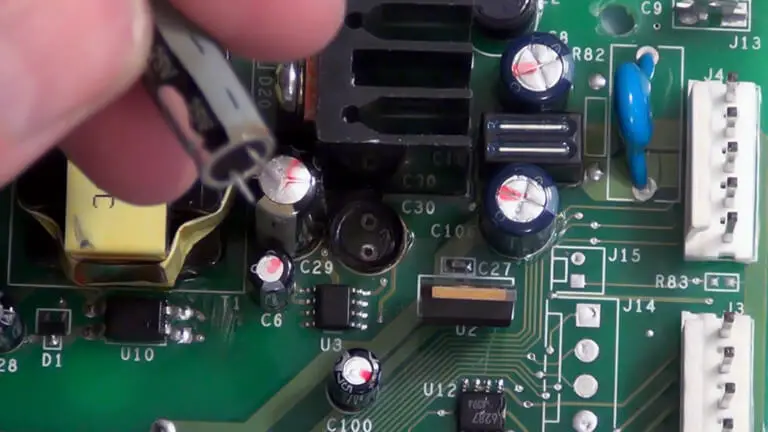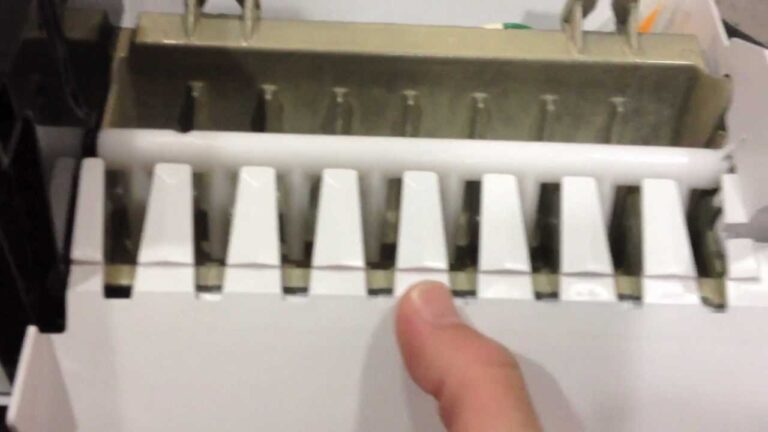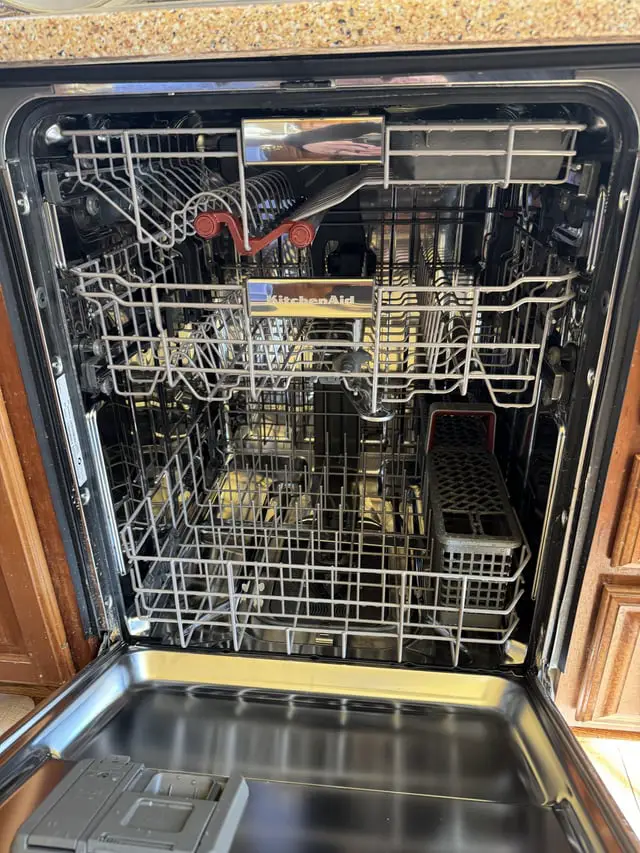GE Refrigerator Control Board Troubleshooting: Quick Fixes
Experiencing issues with your GE refrigerator control board? Symptoms of a bad control board can include cooling problems, erratic behavior, or the fridge not working at all.
These control boards are susceptible to power outages, surges, and static electricity. Common problems with GE refrigerators include water leakage, temperature control issues, and excessive noise. Troubleshooting tips can often resolve these issues. If the display board is not working, check for power and replace it if necessary.
You can also test the control board to see if it’s causing the cooling problem. Follow these guidelines to pinpoint and address the issues with your GE refrigerator control board.

Introduction To Ge Refrigerator Control Board Issues
Discover common GE refrigerator control board issues such as cooling fluctuations, erratic functions, or total malfunction. These control boards, similar to computer systems, can be affected by power disruptions or static electricity. Resolve problems with simple troubleshooting methods for a smoothly running refrigerator.
GE refrigerators are equipped with control boards that help manage the temperature, defrost cycle, and other important functions. However, these control boards can experience issues that can cause problems with your refrigerator’s performance. In this section, we will discuss the common symptoms of a malfunctioning control board and the importance of prompt troubleshooting.
Common Symptoms Of A Malfunctioning Control Board
When the control board of your GE refrigerator is malfunctioning, you may experience a range of symptoms. These symptoms can include:
- Temperature fluctuations
- Fridge not cooling
- Freezer not freezing
- Erratic behavior
- Display panel not functioning
- Strange noises
- Ice maker not working
If you notice any of these symptoms, it’s important to address the issue promptly to prevent further damage to your refrigerator.
Importance Of Prompt Troubleshooting
Prompt troubleshooting of a malfunctioning control board can help you save money on costly repairs or replacement of your GE refrigerator. In addition, it can prevent food spoilage and inconvenience caused by a malfunctioning fridge. When you notice any of the common symptoms of a malfunctioning control board, it’s important to diagnose the issue and fix it as soon as possible.
In conclusion, a malfunctioning control board can cause a range of issues with your GE refrigerator. By identifying the common symptoms of a malfunctioning control board and addressing the issue promptly, you can save money and prevent further damage to your appliance.
Identifying Control Board Problems
When troubleshooting issues with your GE refrigerator, it’s essential to start by identifying control board problems. The control board is the brain of the refrigerator, responsible for regulating temperature, defrost cycles, and other key functions. Understanding how to recognize control board problems can help diagnose and resolve issues efficiently.
Initial Diagnostic Steps
Before diving into control board troubleshooting, perform initial diagnostic steps to assess the overall condition of your refrigerator. Check for common issues such as cooling problems, erratic behavior, or complete malfunction. Ensure the refrigerator is properly plugged in and receiving power to eliminate basic connectivity issues.
Recognizing Error Codes And What They Mean
GE refrigerators are equipped with error code systems that can provide valuable insights into control board problems. When the control board detects an issue, it may display specific error codes. Refer to your refrigerator’s manual or manufacturer’s website to decode these error messages and understand what they signify.
Resetting The Ge Refrigerator Control Board
When your GE refrigerator is experiencing issues such as erratic behavior, cooling problems, or a complete malfunction, resetting the control board can often resolve these issues. The control board acts as the brain of the refrigerator, regulating various functions and ensuring proper operation. Resetting it can help clear any temporary glitches or errors, restoring the refrigerator to normal functioning. Below, you’ll find step-by-step instructions on how to reset the GE refrigerator control board and understand when it’s necessary to perform a reset.
Step-by-step Reset Instructions
- Unplug the refrigerator from the power outlet or turn off the circuit breaker that powers it.
- Wait for 30 seconds to allow the control board to reset completely.
- Plug the refrigerator back in or turn the circuit breaker on.
- Once the power is restored, the control board should reset, and the refrigerator will begin its startup sequence.
When To Perform A Reset
It’s important to know when a reset is necessary to address potential issues with your GE refrigerator. Consider performing a reset in the following situations:
- After a power outage or power surge that may have affected the control board.
- When the refrigerator displays erratic behavior, such as unresponsive controls or unusual error codes.
- If the refrigerator is not cooling properly, despite other troubleshooting efforts.
- When the control board is suspected to be the source of the problem based on diagnostic tests.
Common Ge Refrigerator Malfunctions
GE refrigerators are known for their reliability, but like any appliance, they can experience malfunctions. Understanding the common issues that can arise with a GE refrigerator control board can help in troubleshooting and resolving these problems effectively.
Issues With Temperature Control
One common malfunction in GE refrigerators is temperature control issues. This can manifest as the fridge being too warm or too cold, affecting the freshness of the stored food. The control board is responsible for regulating the temperature, so any malfunction in this component can lead to erratic cooling behavior.
Problems With Water Leakage
Another prevalent issue is water leakage, often stemming from the ice maker. A malfunctioning control board can lead to irregularities in the ice maker’s operation, causing water leaks and potential water damage. Identifying and addressing the root cause of this problem is crucial to prevent further damage and ensure proper functioning of the refrigerator.
Troubleshooting The Control Panel
When it comes to diagnosing issues with your GE refrigerator, troubleshooting the control panel is a critical step. The control panel is the gateway to operating and monitoring your refrigerator, so any malfunctions need to be addressed promptly. In this section, we’ll cover essential steps for troubleshooting the control panel to help you pinpoint and resolve any potential problems.
Testing Button Functionality
If you suspect that the control panel buttons are not functioning correctly, you can perform a simple test to assess their functionality. Here’s how you can do it:
- Press each button on the control panel one by one.
- Observe the response of the display or any corresponding actions.
- Note any buttons that do not elicit a response or appear to be unresponsive.
Assessing Power To The Display Board
Another crucial aspect of troubleshooting the control panel is ensuring that the display board is receiving adequate power. Here’s a basic guide to help you assess power to the display board:
- Check the power supply to the refrigerator and ensure it is functioning properly.
- Inspect the power connections to the display board for any signs of damage or disconnection.
- Use a multimeter to test the voltage at the display board’s power input.
- Compare the measured voltage with the specified operating voltage for the display board.
Diy Quick Fixes For Control Board Issues
When your GE refrigerator control board malfunctions, it can cause a host of problems, from temperature irregularities to complete breakdowns. However, before considering a costly replacement, there are some DIY quick fixes you can attempt to resolve control board issues. These fixes are relatively simple and can save you time and money. Let’s explore some common solutions for control board problems.
Replacing Faulty Capacitors
If your GE refrigerator is experiencing control board issues, faulty capacitors could be the culprit. A capacitor is a small cylindrical component on the control board that stores and releases electrical energy. Over time, capacitors can degrade or fail, leading to control board malfunctions. To address this, you can perform the following steps:
- Unplug the refrigerator and locate the control board.
- Identify the capacitors on the board and check for any visible signs of damage, such as bulging or leaking.
- If damaged, carefully desolder the faulty capacitors and replace them with new ones of the same specifications.
- Resolder the new capacitors onto the control board, ensuring proper polarity and alignment.
- Reassemble the refrigerator and plug it back in to test the control board functionality.
Soldering Burned Relay Joints
Burned relay joints on the control board can also contribute to operational issues in your GE refrigerator. Relays are responsible for switching electrical circuits on and off, and when their solder joints become damaged, it can disrupt the control board’s performance. To remedy this problem, you can follow these steps:
- Disconnect the refrigerator from the power source and access the control board.
- Inspect the relay joints for signs of burn marks, melting, or loose connections.
- Using a soldering iron, reflow the solder on the affected relay joints to ensure proper electrical connections.
- Allow the soldered joints to cool and solidify before reassembling the refrigerator.
- Plug in the refrigerator and monitor the control board for improved functionality.
When To Call A Professional
While some GE refrigerator control board issues can be resolved through home troubleshooting, there are instances where it is best to seek the expertise of a professional technician. Knowing when to call a professional can save time and ensure the problem is fixed correctly.
Limitations Of Home Troubleshooting
Home troubleshooting methods have their limitations, especially when dealing with complex electronic components like refrigerator control boards. Some issues may require specialized knowledge and tools that a typical homeowner may not have.
Finding Qualified Service Technicians
When seeking professional help, it’s essential to find qualified service technicians who are experienced in repairing GE refrigerator control boards. Look for technicians who are certified and have a track record of successfully fixing similar issues.
Preventive Measures And Maintenance Tips
To troubleshoot the GE refrigerator control board, it’s important to take preventive measures such as ensuring a stable power supply and protecting the board from power surges. Regular maintenance tips include cleaning the board and checking for any signs of damage to prevent malfunctions.
Regular Cleaning And Care
To ensure that your GE refrigerator control board works optimally, you need to clean and maintain it regularly. First, unplug the refrigerator from the power source. Clean the exterior with a soft cloth and mild detergent. Then, remove all the items from the interior and clean the shelves, drawers, and walls with warm, soapy water. Dry everything thoroughly before putting the items back. It’s also important to clean the condenser coils located at the back or bottom of the fridge with a vacuum or brush. This prevents the buildup of dust and debris that can affect the fridge’s efficiency.
Protecting Your Refrigerator From Power Surges
Since the GE refrigerator control board is susceptible to power surges, it’s essential to protect it from electrical fluctuations. You can do this by plugging the fridge into a surge protector or installing a whole-house surge protector. These devices prevent voltage spikes from damaging the control board and other electronic components in your home.
Another way to protect your fridge is by avoiding using extension cords or adapters, which can cause voltage drops and surges. Also, never plug in other appliances, such as a microwave or toaster, into the same outlet as your fridge.
Regular Maintenance And Inspection
In addition to cleaning your GE refrigerator control board, it’s crucial to inspect it regularly for any signs of wear and tear. Check the wiring, connectors, and other components for any signs of damage or corrosion. If you notice any issues, you should call a licensed technician to diagnose and repair the problem.
It’s also a good idea to perform routine maintenance tasks, such as checking the temperature settings, cleaning the door gaskets, and defrosting the freezer. These simple measures can help prolong the lifespan of your GE refrigerator control board and prevent costly repairs in the future.
In conclusion, following these preventive measures and maintenance tips can help keep your GE refrigerator control board functioning optimally for many years. By taking care of your fridge, you can avoid the inconvenience of breakdowns and ensure that your food stays fresh and safe to eat.
Concluding Thoughts
When troubleshooting the GE refrigerator control board, it’s essential to consider potential power-related issues such as outages and surges. Look out for cooling problems, erratic behavior, or complete malfunction, which could indicate a faulty control board. Always follow proper safety procedures and seek professional assistance if needed.
Review Of Troubleshooting Steps
If you encounter issues with your GE refrigerator control board, follow these steps:
- Check for power to the display board.
- Test the buttons on the control panel for functionality.
- Perform a linear protection test.
- Conduct an ohms of resistance test.
- Understand the fan circuit and evaporator motor wiring.
- Execute a tachometer test to diagnose further.
Ensuring Long-term Refrigerator Health
To maintain your refrigerator’s well-being:
- Keep the refrigerator clean and free of debris.
- Regularly check and replace air filters if applicable.
- Monitor temperature settings for optimal performance.
- Avoid overloading the refrigerator to prevent strain on the control board.
- Schedule periodic maintenance checks to detect issues early.
Effective GE refrigerator control board troubleshooting is crucial to ensure the longevity of your appliance. By following the recommended steps and prioritizing maintenance, you can prevent major malfunctions and enjoy a consistently reliable refrigerator. Remember, a well-maintained control board is key to the overall health of your refrigerator.
Frequently Asked Questions
What Are The Symptoms Of A Bad Refrigerator Control Board?
Symptoms of a bad refrigerator control board include cooling issues, erratic behavior, or complete failure. Control boards are sensitive to power outages and static electricity, similar to computer boards.
How Do I Reset My Ge Refrigerator Control Board?
To reset your GE refrigerator control board, unplug the fridge for 5 minutes, then plug it back in.
What Is The Most Common Problem With Ge Refrigerators?
The most common problem with GE refrigerators includes water leakage from the ice maker, temperature control issues, and excessive noise. The control board, which acts as a computer board, can also cause cooling problems, erratic behavior, or the fridge not working at all due to power outages, surges, spikes, and even static electricity.
Troubleshooting tips can help solve many of these issues easily.
Why Is The Control Panel On My Ge Refrigerator Not Working?
The control panel on your GE refrigerator may not work due to a faulty electronic control board, LED light assembly, or user interface malfunction.
Conclusion
Troubleshooting a GE refrigerator control board is essential for resolving various issues like cooling problems or erratic behavior. By following proper steps and understanding common problems, you can easily fix your refrigerator and ensure its optimal performance. Remember to consult professionals if needed for expert assistance.






